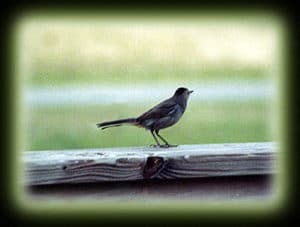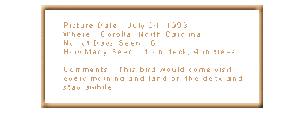Gray Catbird
Dumetella carolinensis
Family: Mimidae
The Gray Catbird is a slim all gray-slate bird with a black cap and chestnut undertail. The tail is black and long. The female is similar to the male except a little paler. This bird is 9″ in length with a wingspread of 11-12″.
The Gray Catbird is a migratory bird with their migration performed mostly during night, when they move slowly from bush to bush. Pennsylvania is favored by them and they can be seen along a field, garden or orchard. They live in dense thickets, bushy trees or vines and edge of forests. The male arrives to the breeding grounds a few days before the female and will sing from atop a bush.
Like all other thrushes, the Gray Catbird is very fond of bathing and rolls itself in the dust or sand of the roadsides or fields. Several are frequently seen together on the borders of small ponds, splashing the
water all over themselves and then going to the nearest bush or tree.
Song:
The song of the Gray Catbird is a cat-like meow and will often sing at night. They imitate calls of jays, kingfishers, swallows, grosbeaks, and many songbirds.
Range:
Migratory. Winters in southern US to Panama and West Indies. Breeds across most of the US and southern Canada.
Nesting/Eggs:
The nest is large and composed of dry twigs, mixed with withered leaves, weeds and grasses, and lined with dark fibrous roots and pine needles. The nest is neatly arranged in a circular fashion and can be found in a shrub, tree or dense vegetation near a creek anywhere between 3-15 feet above ground. Throughout the months of May-August, as many as three broods are raised, but normally only two broods. The 4-6 eggs are glossy greenish-blue. The eggs hatch within 12-14 days and are incubated by the female. The first young will leave the nest 11-14 days after hatching.
Natural Feeding Habits:
This bird’s diet is approximately 60% insects, such as beetles, caterpillars, cicadas, crickets, grasshoppers, moths, ants, aphids and spiders, and the other 40% consists of fruit such as wild berries, especially blackberries, berries of sweet gum, grapes and seeds of grasses.
Feeding Stations:
Will sometimes come to feeding stations for peanuts, currants, raisins and bread.
Other Names:
Another name for the Gray Catbird is Slate-colored Mockingbird.


